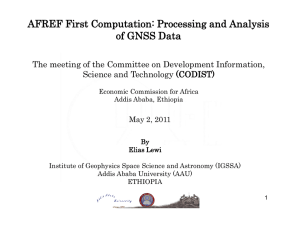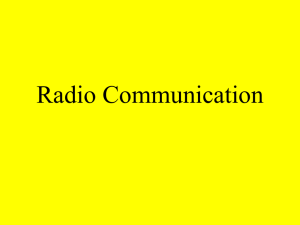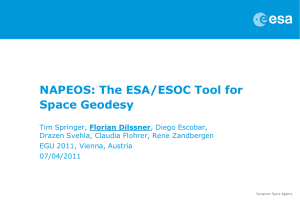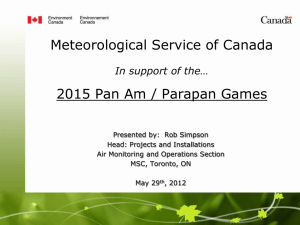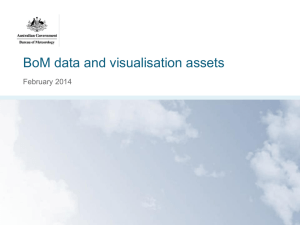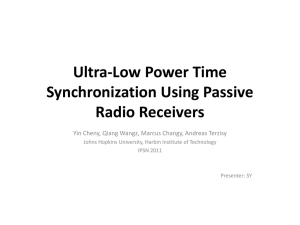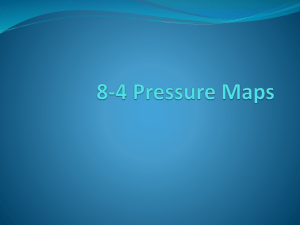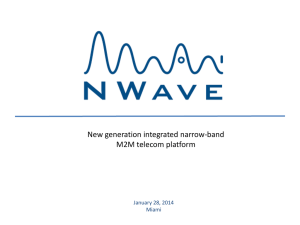OBJECTIVES OF AFREF - United Nations Economic Commission for
advertisement
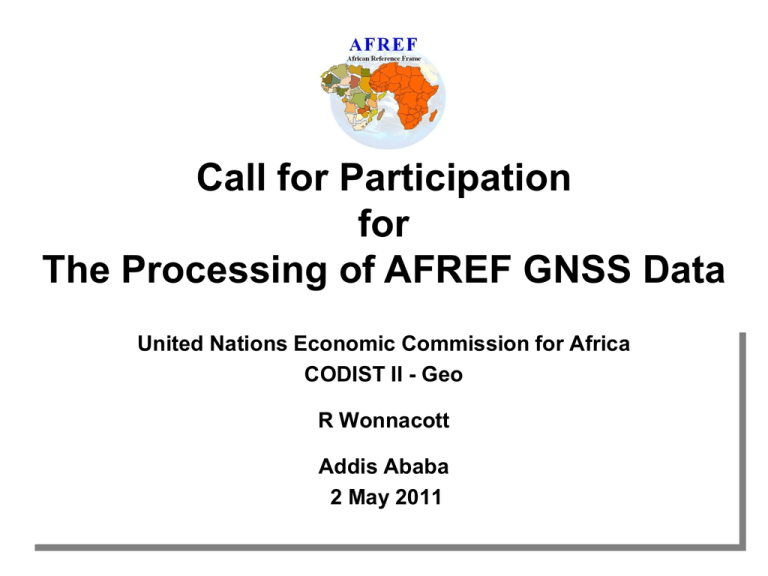
Call for Participation for The Processing of AFREF GNSS Data United Nations Economic Commission for Africa CODIST II - Geo R Wonnacott Addis Ababa 2 May 2011 Overview • Executive Summary • Summary of Call for Participation • Details of Areas of Participation • Background to AFREF • References Background • Fundamental point of departure for projects, services or products requiring geo-spatial information is a uniform & reliable co-ordinate reference frame. • Over 50 countries in Africa each with their own geodetic reference system and frame and some with 2 or more systems. • Although there are many areas of conflict there are also areas where peace has been restored and require a lot of development. • It is known that many private commercial enterprises are setting up their own reference frames particularly in the oil and mining industries. • AFREF is, therefore, an African initiative to unify the geodetic reference frames of Africa based on the ITRF through a network of GNSS base stations at a spacing such users will be at most within ~1000 km of a base station. International Endorsement • UN ECA CODIST (Committee on Development Information, Science & Technology) – Have adopted the Windhoek Declaration – Created a Working Group to deal specifically with AFREF • UN OOSA (UN Office for Outer Space Affairs) – Have recognized the importance of AFREF for variety of applications – Supported travel for some AFREF activities • IAG (International Association of Geodesy) – Have created structures to co-ordinate the project and provide technical assistance and expertise • IGS (International GNSS Service) – Has strong commitment to support AFREF Objectives of AFREF 1 – To determine a continental reference system for Africa consistent and homogeneous with the global reference frame of the ITRF as a basis for national 3-d reference networks. – To realize a unified vertical datum and to support efforts to establish a precise African geoid. – To establish continuous, permanent GNSS base stations at a spacing such that the users will be within 1000km of a base station and that data is freely available to all nations. Objectives of AFREF 2 – To determine the relationship between the existing national reference frames and the ITRF to preserve legacy information based on existing frames. – To provide a sustainable development environment for technology transfer so that these activities will enhance the national networks and other applications. – Assist in establishing in-country expertise for implementation , operation, processing and analysis of modern geodetic techniques, primarily GNSS. Progress to Date 1 • The AFREF Operational Data Centre (ODC) is currently archiving on a daily or near daily basis data from nearly 62 permanent GNSS base stations at average of 31 stations daily ( as at mid-April 2011). • Data is freely and openly available to all users. • Project reached the stage where a computation of all available stations can be carried out. • National Mapping Organizations will be able to use results plus available GNSS data from ODC to compute National Reference Frames based on ITRF. Progress to Date 2 Active stations being archived at the AFREF Operational Data Center (February 2011) Progress to Date 3 Number of activities underway to install permanent base stations or move towards ITRF: Algeria Benin Cameroon Ethiopia Kenya Malawi Mozambique Nigeria South Africa Tanzania Uganda Angola Botswana Egypt Ghana Lesotho Moroco Namibia Rwanda Swaziland Tunisia Zambia Progress to Date 4 As agreed at CODIST I (April 2009), an Operational Data Centre has been established. – www.afrefdata.org or ftp.afrefdata.org – Data from 62 (mid-April 2011) continuous stations brought together from number of data centres into one place. Data centres include: • CDDIS • HartRAO • NGS • TrigNet • UNAVCO • Nignet • SEGAL • Plus data from 3 stations being directly downloaded from receivers Progress to Date 5 – Number of stations listed for which no data available - it is known that these stations are operating but data not available. – Number of campaign stations listed hence only periodic data available . Areas of Participation 1 Processing and analysis of data from the network of GNSS base stations to produce a continental reference frame: – Computation of network of fiducial stations based on well established stations with long term reliability and publically available data; – An initial processing will provide set of co-ordinates for use at National level - frozen in time; – In addition will provide ongoing processing to maintain network and provide set of velocity vectors and to make allowance for the addition of new stations; – Processing to be done using IAG guidelines. Areas of Participation 2 Computation of national networks based on the continental reference frame: – Major objective project is conversion of National geodetic networks to AFREF and hence ITRF; – NMOs will have to occupy number of strategically placed points whose co-ordinates are well established in the National frame using GNSS; – Processing could either be as series as campaign or using permanent stations to convert / transform current frame to AFREF; – Respondents will have to set out proposed strategy. Areas of Participation 3 Training and capacity building of geodesists and surveyors in NMOs and Universities – Respondents to CfP will be required to address the following: – Describe the form of training whether for individuals or components of NMOs; – In case of individual training, will training lead to some form of qualification?; – What level of sponsorship will be offered, if any? ; – Proposal must describe level of expertise required to undertake training; and – Any other details not covered in the above. General - Call for Participation includes a section on the background to AFREF which will not be covered in this presentation. - Commitment to project to be at least 5 years to create an environment for sustainable environment. - Proposals to be evaluated by panel of independent experts. - The CfP also covers multi-disciplinary aspects of AFREF such as collaborations with; - Africa Array - seismology - Africa Monsoon Multi-disciplinary Array-GPS (AMMA-GPS) – meteorology - Scintillation Network Decision Aid (SCINDA) – space weather - Dates for submission of CfP proposals still to be finalized. Inter-disciplinary Collaboration Thank you Global Context 1 Global distribution of four space based positioning techniques available for realization of International Terrestrial Reference Frame (ITRF) + GPS Only ; + DORIS only; + SLR Only; + VLBI Only 4 Techniques; 3 Techniques; 2 Techniques Global Context 1
